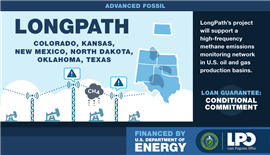Methane detection tech may get U.S. financial support
January 08, 2024
LongPath Technologies in line for $189 million in loan guarantees

Plans to install a real-time methane emissions monitoring network across major basins is getting backing from the U.S. Department of Energy (DOE)
Emissions management company LongPath Technologies received conditional commitment for up to $189 million in loan guarantees from the (DOE) to support the fabrication and installation of a real-time methane emissions monitoring network. The monitoring would include the Permian, Denver-Julesburg, and Anadarko oil and gas production basins across Colorado, Kansas, Oklahoma, New Mexico, North Dakota, and Texas. LongPath’s Active Emissions Overwatch System project aims to cover 25 million acres of land with large-area remote methane monitors, providing emissions detection, location, and quantification services for tens of thousands of oil and gas sites through a subscription service.
If finalized, the network is expected to prevent methane emissions equivalent to at least six million tons of carbon dioxide annually by enabling subscribers to identify and respond to methane leaks quickly, according to the DOE.
The plan is aligned with the goals of the Methane Emissions Reduction Program, created by the President’s Inflation Reduction Act, and helping states support industry efforts to cut methane emissions.
Emissions of methane, a greenhouse gas up to 80 times more potent than carbon dioxide, occur across the oil and gas sector. Leaks during oil and gas production and compression, which are difficult to identify across vast production areas, are a major source of U.S. methane emissions. The longer leaks go undetected, the more planet-warming greenhouse gas enters the atmosphere. Today, monitoring is typically conducted via flyovers or using methods such as optical gas imaging (OGI) cameras, which can leave major gaps in emissions monitoring over time and space, respectively, and lead to methane leaks potentially going unnoticed for weeks or months, or undetected entirely. This is particularly true because emissions are intermittent—only continuous monitoring can reliably detect these kinds of emission sources.
In contrast, LongPath’s technology is designed to continuously identifies, localizes, and quantifies methane emissions more rapidly and at lower detection levels than conventional methods, allowing operators to mitigate leaks earlier and more often. For example, the LongPath Active Emissions Overwatch System could reduce greenhouse gas emissions leaks by approximately 90% versus the incumbent OGI technologies. In part, this is made possible because LongPath monitors sites multiple times a day, whereas OGI is often used much less frequently. The company already has nearly hundreds of square miles of oil and gas infrastructure under monitoring of its systems (i.e., 50-foot towers topped with lasers that monitor an area of nearly 8 square miles). If finalized, the LPO financing will support them in the deployment and installation of up to 24,000 square miles of coverage.
The technology, which was developed with the University of Colorado and the National Institutes of Standards and Technology (NIST), and with support from DOE’s Advanced Research Projects Agency–Energy (ARPA-E) and other DOE grants, uses an eye-safe laser to accurately identify molecules in the air, including greenhouse gases like methane. A single laser can continuously monitor nearly 8 sq. mi. for emissions, providing updates of the full area as often as every two hours. The system can notify operators in the event of a leak (down to .06 kg/hr) to facilitate a rapid response, reducing needless emissions and generating savings across the value chain.
While this conditional commitment demonstrates the Department’s intent to finance the project, the project must satisfy certain conditions, which may include reaching technical, legal, commercial, contractual, or other milestones, before the Department issues a final loan.
MAGAZINE
NEWSLETTER
CONNECT WITH THE TEAM






